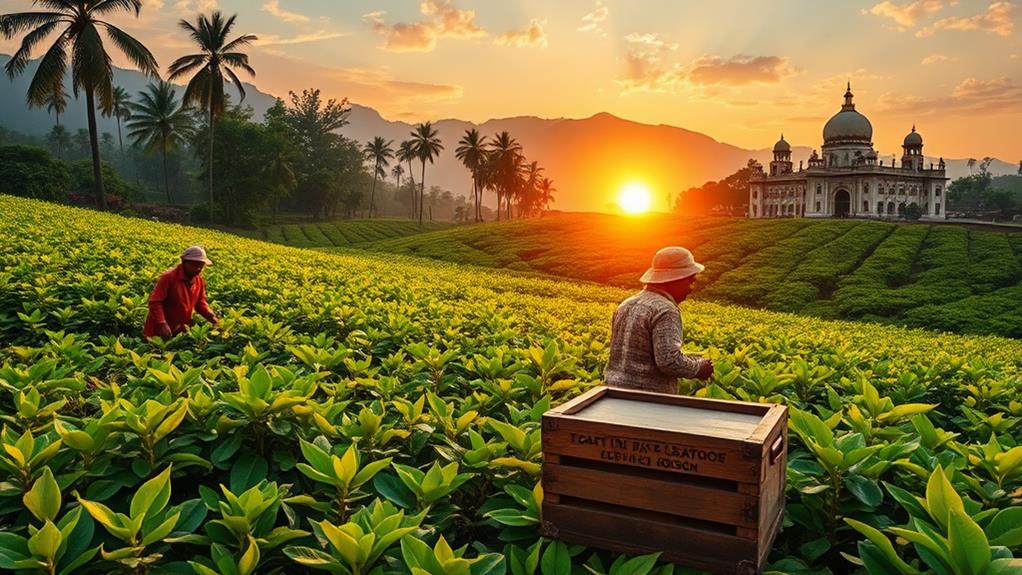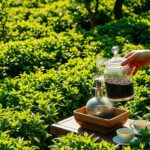Tea's journey through history is deeply connected to colonialism, especially via the East India Company. Established in the early 1600s, it linked Europe and Asia, transforming tea from a rare luxury into a daily staple in Britain. As tea became popular, it shaped social gatherings like afternoon tea, marking sophistication and class. However, this trade caused economic disparity and environmental changes in the colonies. Tea also became a symbol of resistance, with events like the Boston Tea Party pushing back against colonial rule. Understanding tea's past reveals how it still connects cultures today, inviting you to explore its rich legacy further.
The Origins of Tea
Tracing back to ancient China, tea's origins reveal a rich tapestry of culture and tradition. You might be surprised to learn that tea was discovered by Emperor Shen Nong in 2737 BCE when leaves accidentally fell into his boiling water. This happy accident sparked a beverage that would shape societies.
As you sip your cup today, think about the journey it took! Green tea, in particular, has evolved over centuries, with unique varieties such as Sencha and Longjing showcasing regional flavors and traditions.
In its early days, tea wasn't just a drink; it held medicinal properties and served as a status symbol among the elite. By the Tang Dynasty, tea gained popularity and became an art form, with elaborate ceremonies showcasing its importance. People began experimenting with flavors and brewing styles, paving the way for the diverse teas we enjoy now.
As you investigate the world of tea, consider how it connects cultures across continents! From the tranquil tea houses in Japan to the bustling markets of India, each region adds its unique twist.
The Rise of the East India Company
How did the East India Company rise to prominence and transform the global tea trade? It all started in 1600 when a group of merchants banded together to create a powerful trading company. Their goal was to capitalize on the spice trade, but soon they discovered tea's potential. With its growing popularity in England, the Company expanded its reach in Asia, establishing trade routes that made tea widely accessible.
Here's a quick look at key factors in the Company's rise:
| Factors | Impact |
|---|---|
| Trade Monopolies | Controlled tea supply |
| Strategic Alliances | Gained local support |
| Innovative Shipping | Reduced transport costs |
| Marketing Strategies | Boosted tea's popularity |
As the East India Company grew, it didn't just bring tea to England; it changed how people enjoyed it. The demand for tea skyrocketed, making it a staple in British households. This transformation also set the stage for future cultural shifts. So, the next time you sip your tea, remember the pivotal role the East India Company played in shaping this beloved beverage!
Tea and British Society
The East India Company's success didn't just change the tea trade; it profoundly impacted British society. Imagine sipping a cup of tea while discussing the latest inventions or political ideas—that's how tea became central to daily life in Britain.
As tea drinking spread, it transformed social gatherings and became a medium for social connection, just as it does in other cultures around the world a common thread in tea culture. Afternoon tea emerged as a fashionable ritual, where people would come together to enjoy this exotic beverage and share stories.
Tea also played a role in shaping British identity. It symbolized sophistication, and its consumption often signified class and status. You could even say that tea was a great equalizer, bringing together people from different backgrounds.
However, it wasn't just a drink; it influenced how you thought about time and relaxation. The British began to embrace slower moments in their day, leading to a cultural shift toward valuing leisure.
This beverage became a bridge between tradition and modernity, fostering conversations about art, science, and society.
Colonial Trade Routes
When you think about the East India Company, you can't ignore the complex colonial trade routes that made it possible for tea to flow from India to Britain.
These historical trade networks shaped economies on both sides and had a lasting impact on global commerce.
Understanding these routes helps you appreciate how a simple cup of tea carries with it stories of exploration, exchange, and economic shifts.
Historical Trade Networks
Colonial trade routes forged by the East India Company created a complex web that connected Europe, Asia, and beyond. Imagine bustling ports and ships filled with exotic goods, sailing across oceans to meet the insatiable demand for tea, spices, and textiles. These routes weren't just paths on a map; they were lifelines that shaped economies and cultures on both sides of the globe.
The emergence of the Tea Act in 1773 exemplified how deeply intertwined these trade networks were with colonial governance and resistance.
As you explore these historical trade networks, you'll notice how they facilitated the exchange of ideas, not just products. Merchants, sailors, and traders shared stories, customs, and technologies, transforming local practices. This interaction fostered a unique blend of cultures, giving rise to innovations that continue to influence us today.
The East India Company didn't operate in isolation. Its trade routes connected distant lands, creating a vibrant marketplace where you could find everything from Indian silk to Chinese porcelain.
While traversing these networks, the Company established relationships that would have lasting impacts, both positive and negative. Understanding these routes helps you appreciate the intricate dance of commerce and culture that shaped our world, reminding us that history isn't just about facts—it's about connections that still resonate today.
Economic Impact Analysis
Understanding the historical trade routes reveals a deeper layer of economic impact that shaped both the colonies and the mother country. As you explore these routes, you'll notice how the East India Company transformed trade into a powerful engine of wealth. The demand for tea in Britain skyrocketed, leading to a surge in exports from the colonies. This wasn't just about sipping tea; it fueled industries, created jobs, and influenced everyday life.
Imagine the bustling ports where ships arrived, laden with tea, spices, and textiles. Each journey not only enriched the Company but also sparked innovation in shipping and logistics. The introduction of new products led to a shift in consumer culture back home, as people enthusiastically embraced exotic goods.
However, this success came at a cost. Local economies in the colonies often suffered as resources were drained, pushing them into dependence on British trade.
While you can appreciate the innovation sparked by these trade routes, it's crucial to recognize the complex legacy they left behind. So, as you sip your next cup of tea, think about the intricate web of history that shaped its journey to your table!
Economic Impact of Tea
Tea's economic impact during the era of the East India Company can't be overstated; it transformed trade routes and fueled colonial economies. The demand for tea skyrocketed, leading to a flourishing trade network that connected continents. As a result, entire industries emerged, creating jobs and boosting local economies.
Here's a closer look at some key economic aspects:
| Aspect | Impact | Example |
|---|---|---|
| Trade Routes | Expanded global trade | Ships traveled from India to Britain |
| Job Creation | Increased employment in tea estates | Thousands worked in plantations |
| Local Economies | Boosted income for local farmers | Farmers earned more from tea production |
| Cultural Exchange | Brought diverse goods to markets | Spices and textiles enriched trade |
Through these developments, tea not only became a beloved beverage but also a powerful economic force. It shaped how nations interacted and laid the groundwork for modern global trade. So, next time you sip your favorite tea, remember its rich history and the economic waves it created around the world!
Cultural Exchange Through Tea
Throughout history, the exchange of tea has sparked fascinating cultural interactions between nations. You mightn't realize it, but each cup of tea tells a story of collaboration, creativity, and innovation. When tea made its way from China to Britain, it didn't just bring a beverage; it introduced new customs and ways of life, influencing the development of unique tea rituals, such as the ceremonial practices that became integral to many cultures.
Imagine the first time you sipped green tea or chai; it likely felt like a gateway to another world!
As tea spread, so did ideas. In Japan, the ceremony of tea became an art form, emphasizing mindfulness and beauty. Meanwhile, in India, chai stalls became social hubs where people shared stories and laughter. These moments fostered connections and sparked the birth of fusion drinks, like the popular bubble tea we enjoy today.
The cultural exchange through tea has also inspired countless art forms, from poetry to paintings, as people express their love for this beloved beverage.
Resistance and Rebellion
As tea became a symbol of cultural exchange, it also played a significant role in resistance and rebellion against colonial powers. Imagine sipping a cup of tea while discussing plans to challenge oppression. For many colonized nations, tea wasn't just a beverage; it was a rallying point.
The East India Company's control over tea trade sparked growing resentment, leading to protests and uprisings. Tea's health benefits and comforting nature provided solace and strength to those fighting against injustice.
In India, groups like the Sepoys took a stand, fueled by a sense of injustice. They recognized that tea, a daily comfort, represented something much bigger—a fight for autonomy.
In America, the Boston Tea Party showcased how tea could unite people against unfair taxation. By dumping tea into the harbor, revolutionaries sent a clear message: they wouldn't be silenced.
These acts of defiance were more than just symbolic; they inspired others around the globe to challenge colonial rule.
So, the next time you enjoy a cup of tea, remember its powerful history. It's not just about flavor; it's about tradition, resilience, and the spirit of those who stood up for their rights.
Tea truly brewed a legacy of resistance that resonates even today.
The Role of Women
Women played an essential role in shaping the tea culture that emerged during the East India Company's dominance. As tea became a symbol of sophistication and social status, women took charge of introducing and popularizing it in their households.
With their keen sense of taste and style, they transformed tea drinking into an art form, hosting tea parties and creating elegant rituals that would captivate everyone.
In many ways, women were the unsung heroes of this cultural shift. They crafted the delicate recipes that paired tea with delicious snacks, encouraging conversation and connection. You might picture them sipping tea in beautifully decorated rooms, sharing stories and laughter, as they solidified tea's place in society.
Moreover, women also played a significant role in the tea trade, whether through their influence in households or by working in tea plantations. Their involvement not only shaped the tea industry but also laid the groundwork for future generations.
Legacy of Colonialism
The tea culture that flourished under the East India Company exists against a backdrop of colonialism, which greatly influenced both the production and consumption of tea. This legacy isn't just about sipping a warm cup; it's about understanding how history intertwines with what you drink today.
The impact of colonialism on tea is profound, shaping not only trade routes but also cultural practices.
You might find it interesting to reflect on these aspects of tea's colonial legacy:
- Cultural Exchange: The blending of British and Indian traditions created unique tea rituals that persist today.
- Economic Disparities: The profits from tea often enriched the colonizers while leaving local producers in hardship.
- Environmental Changes: The establishment of tea plantations drastically altered landscapes and biodiversity.
As you explore your next cup of tea, remember that it's more than just a beverage. It's a symbol of a complex history.
By understanding this legacy, you can appreciate the intricate connections between your tea and the world it comes from, creating a richer experience with every sip.
Isn't it fascinating how a simple drink can carry such depth?
Modern Tea Consumption
When you think about modern tea consumption, it's fascinating to see how global tea trends have evolved over the years.
You might notice that different cultures have their own unique practices, from afternoon tea in England to matcha ceremonies in Japan.
Plus, many people are exploring the health benefits of tea, discovering that this beloved beverage can do wonders for well-being!
Global Tea Trends
Tea culture has evolved considerably in recent years, reflecting shifting consumer preferences and lifestyles. You might notice that tea isn't just a drink anymore; it's become a lifestyle choice. With the rise of health consciousness and innovation, tea is now at the forefront of global trends.
Here are a few exciting changes you might see in the world of tea:
- Flavor Fusion: Unique blends and flavors, like matcha lattes and chai-infused smoothies, are popping up everywhere.
- Sustainable Choices: Many brands are focusing on organic and ethically sourced teas, appealing to eco-friendly consumers.
- Convenience: Ready-to-drink teas and innovative brewing methods, like tea pods, make enjoying your favorite beverage easier than ever.
These trends show how tea is adapting to modern life. You can explore the world of tea with new eyes, discovering unique varieties and health benefits.
Whether you're a casual drinker or a dedicated enthusiast, there's something fresh waiting for you. So, why not experiment with a new flavor or try an innovative brewing method? Embrace the exciting world of tea and make it a part of your daily routine!
Cultural Tea Practices
As tea continues to evolve with global trends, cultural practices around tea consumption are also transforming. You might notice that tea isn't just a drink anymore; it's an experience! People are blending flavors, experimenting with new brewing techniques, and even using tea in cooking. Whether it's matcha lattes or bubble tea, innovation is everywhere.
In many places, tea has become a social event. You can find tea bars popping up, where friends gather not just to sip but to savor unique blends. Envision this: you and your friends trying a zesty hibiscus tea while sharing laughs and stories. It's not just about hydration; it's about connection.
You might also see tea ceremonies adapting to modern life. While traditional practices are still cherished, many are embracing a more casual approach. Imagine hosting a tea tasting party, where you introduce your pals to exotic leaves from around the world.
Health Benefits Explored
Exploring the health benefits of modern tea consumption reveals a wealth of advantages that can enhance your well-being.
Tea isn't just a delightful drink; it's packed with nutrients and antioxidants that can uplift your health. From boosting your immune system to promoting hydration, it's a simple addition to your daily routine that brings big benefits.
Here are three key health perks of enjoying tea:
- Antioxidants: Tea is rich in polyphenols, which help fight free radicals, reducing oxidative stress in your body.
- Heart Health: Regular tea drinkers may have lower risks of heart disease, as certain teas can improve cholesterol levels and support blood vessel function.
- Mental Clarity: The caffeine and L-theanine in tea can enhance your focus and alertness, giving your brain a nice boost without the jitters.
FAQ
How Did Tea Influence British Fashion and Etiquette?
Tea shaped British fashion and etiquette by introducing formal gatherings, inspiring elegant attire, and establishing ritualistic customs. You'll notice how these elements reflect sophistication and status, influencing social interactions and personal expression throughout history.
What Was the Environmental Impact of Tea Plantations?
You'll find that tea plantations considerably altered ecosystems, leading to deforestation and biodiversity loss. As you explore sustainable practices, consider how reforestation and responsible farming can mitigate these environmental impacts while promoting healthier ecosystems.
How Did Tea Trade Affect Indigenous Populations in India?
The tea trade greatly disrupted indigenous populations in India, altering their livelihoods and social structures. You'll notice how economic pressures and land dispossession led to cultural shifts, impacting their identity and traditional practices over generations.
What Are the Health Benefits and Risks of Tea Consumption?
Did you know that 3-5 cups of tea daily can reduce heart disease risk by 20%? While tea boosts metabolism and hydration, too much caffeine can lead to anxiety or insomnia. Balance's key for ideal health.
How Is Tea Production Evolving in Today's Global Market?
Tea production's evolving rapidly, embracing sustainable practices and innovative technology. You'll find growers experimenting with new varieties and eco-friendly methods, ensuring quality while meeting the rising demand for unique flavors in today's dynamic global market.
Final Thoughts
So, next time you sip your cup of tea, remember its rich history—one that's brewed from colonialism and trade. Isn't it ironic? What started as a simple pleasure has roots in exploitation and resistance. While tea brings us together today, it also carries the weight of its past. By understanding this legacy, we can appreciate our tea not just for its flavor, but for the stories it tells about culture, trade, and resilience. Cheers!



